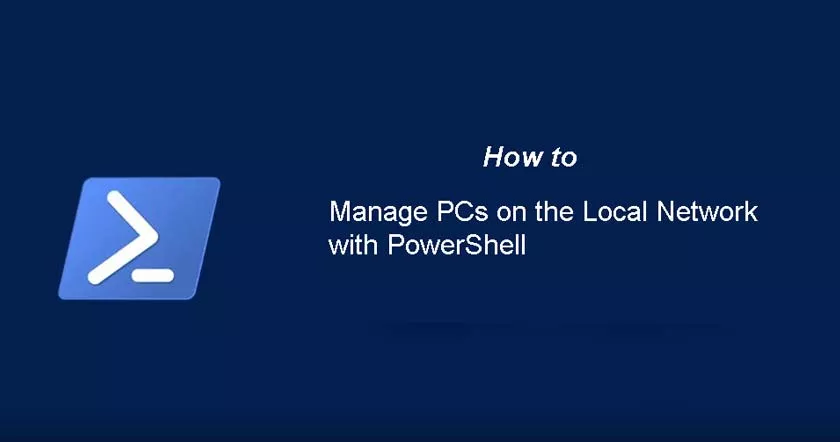Let’s see how it is possible to connect to the various Windows PCs connected in the local network from a single workstation that will act as an administration console.

Windows offers everything you need tocheck the status of PCs connected to the local network through the PowerShell window.
PowerShell, introduced by Microsoft, is a command-line shell and scripting language designed for system administration. It combines the power of a traditional command prompt with the flexibility of scripting, making it ideal for automating complex tasks.
In a local network setup, where multiple PCs need to be managed, PowerShell enables administrators to perform tasks such as:
- Monitoring system performance
- Installing or updating software
- Managing user accounts
- Configuring network settings
- Troubleshooting common issues
PowerShell’s remote capabilities make it a go-to solution for IT professionals tasked with managing distributed systems efficiently.
How to Manage PCs on the Local Network with PowerShell
And that systems need not be attested on the same domain and managed through Active Directory: the ability tomanage the LAN connected PC Remote can also be used on machines belonging to the same workgroup(workgroup).
In this way, using your personal console, you willbeable tocheck the configuration of the other PCs, the installed updates, change their operating parameters, run scripts, arrange for a restartand much more.
Before trying your hand at the systems you use in production, we suggest carrying out some tests using virtual machines connected to the local network as if they were physical systems (Cardsettingwith bridgein the case of the virtual network interface of the Virtualboxvirtual machine ).
Tomanage the PCs in the local network remotely using only PowerShellthe procedure is all in all quite simple but it is important to pay the utmost attention to each step.
Setting Up PowerShell for Network Management
Before managing PCs on a local network with PowerShell, you need to ensure the environment is set up correctly. Follow these steps:
1. Enable PowerShell Remoting
PowerShell Remoting allows you to run commands on remote PCs. To enable it:
- Open PowerShell as an administrator.
- Run the following command:
- Ensure that all target PCs have PowerShell Remoting enabled.
2. Configure Network Settings
- Ensure that all PCs are on the same local network and can communicate with each other.
- Disable any firewalls or configure them to allow PowerShell traffic:
3. Set Up Credentials
To execute commands on remote machines, you need valid administrative credentials:
4. Verify Connection
Test the connection to a remote PC using the Test-Connection cmdlet:
PowerShell Cmdlets for Managing Local Network PCs
Here are some commonly used PowerShell cmdlets for managing PCs in a local network:
1. Retrieve System Information
Use Get-ComputerInfo to gather detailed system information:
2. Manage Processes
List running processes on a remote PC:
3. Manage Services
Start, stop, or restart services:
4. Manage Software
Install software remotely using Invoke-Command:
5. Manage User Accounts
Add a new user account:
6. Monitor Network Performance
Get network adapter statistics:
7. Transfer Files
Copy files to a remote PC:
Advanced Use Cases
PowerShell’s capabilities extend beyond basic management. Here are some advanced scenarios:
1. Active Directory Integration
Automate user management in Active Directory using cmdlets like:
5.2. Bulk Operations
Perform tasks on multiple PCs simultaneously:
5.3. Security Auditing
Generate security reports for the network:
5.4. Custom Scripts
Create scripts to address unique requirements. Example: Monitoring disk usage:
Benefits of Managing PCs with PowerShell
Managing PCs using PowerShell offers several advantages:
- Automation
Routine tasks can be automated using scripts, saving time and reducing human error. - Remote Administration
PowerShell allows administrators to execute commands on remote systems without physical access. - Scalability
With a single script, you can manage multiple machines, making it ideal for large networks. - Integration
PowerShell integrates seamlessly with other Microsoft tools like Active Directory, Exchange Server, and Azure. - Customizability
PowerShell scripts can be tailored to meet specific requirements, ensuring flexibility.
Conclusion
PowerShell is a powerful tool for managing PCs on a local network. Its flexibility, combined with robust scripting capabilities, allows administrators to perform tasks efficiently and effectively. By mastering the techniques outlined in this guide, you can optimize your network management workflows and reduce manual effort.
Whether you are managing a small office network or an enterprise-scale infrastructure, PowerShell provides the tools needed to streamline operations and maintain control. Start experimenting with these commands and scripts, and gradually explore advanced functionalities to unlock the full potential of PowerShell.
